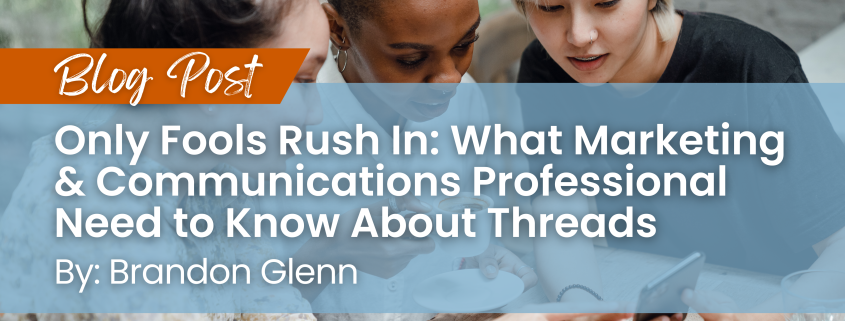
by Margaret Kelly | Nov 1, 2023 | Blog
One of my guilty pleasures is watching animal videos – because who doesn’t love otters having fun in the water or cows playing with balls? The captivating power of photos and videos should also be considered when creating a press release.
When your company wins a contract, achieves a major award or releases a new product, you might find it important enough to warrant a press release. To grab the attention of a journalist, consider adding a photo or video.
In the same way an image captures your attention on social media, an extra photo or video (an “asset” in industry jargon) in a press release will get the attention of the media. In fact, Amendola’s release partner, PR Newswire (a Cision company), reports that adding an asset to a release will increase your media coverage by 600%.
But gaining media coverage is just the start.
In the words of Bonnie Raitt, let’s give them something to talk about
A press release contains the information you want to share – but why not give readers more? By inserting a link in the release, you can take them to a landing page on your website where they can learn more. Too often, however, such links and calls to action are pushed to the last paragraph.
Best practices call for no more than three hyperlinks in any one press release. Therefore, consider linking to your corporate website only in the boilerplate and not in the first paragraph. The aim is to provide the journalist with as much information upfront as possible before they click on your website to learn more about your company and products.
As for your call to action, a picture (or video) is worth a thousand words. To maximize your reach, create a unique asset to place in the right-hand column of the press release, next to the first paragraph.
Creative assets to consider include:
- A headshot for a new hire
- An infographic or a link to the first page thumbnail for a case study.
- For an award, an image of the award or a photo of the person being awarded
- If you have won a contract, add the new partner’s logo or a photo of their headquarters
- For a new product, include a screenshot or video of the product’s dashboard.
Adding an asset to a release currently increases the cost of your release by about $400 – but the return could be great if it increases your press release impressions by 600%!
Here’s an added benefit: Once you have created these assets, you can re-use them for other marketing initiatives, such as within newsletters, reports to stockholders, social media, collateral during tradeshows, and much more.
One last tip: As soon as your press release is ready to hit the wire, upload it to the “news” page on your website. Avoid frustrating journalists (and clients and prospects) who are looking for the latest company news, only to find releases from six months ago. Instead of linking back to the PR Newswire version, load the news directly to your website to ensure readers stay on your site.
Keeping your news site fresh and your press releases captivating may earn you a thank you from the press, clients and prospects!

by Grant Evans | Oct 11, 2023 | Blog
Now that some of the initial hype and hysteria surrounding generative AI has ebbed, perhaps it’s time to take a clear-eyed look at what the technology really means to marketing (and specifically, the content creation community).
I was on a call with a client recently and, just like so many of these conversations with those in healthcare IT go these days, the conversation turned to AI. “No one is losing their job to ChatGPT,” he said. This made me think back to the flurry of coverage that stemmed from a Washington Post article published a few months ago telling about a young content writer who claimed she lost her job to ChatGPT.
In the following weeks, when the alarms were sounded predicting the demise of human-generated content, my BS meter’s needle pegged into the red.
If you hear “content” and think “long-form thought leadership” or “white paper” or “contributed byline article” or “executive presentation” then you’re not alone. But all too often, these forms of true content are lumped in with the mountains of text blurbs, Google ads, and meta descriptions that command much of the time of “copywriters.” This “stuff” isn’t really content; its main purpose is to spur search rankings. It’s marketing spam.
Whether it’s Perplexity.ai, ProWritingAid, QuillBot, WordTune, Claude.ai, Jounce, Copy.ai, or the good old instigator, ChatGPT, you can find a platform that will readily churn out passable short-form stuff. Some can even produce a serviceable low-level (read: throw-away) press release. That said, they all still require a degree of handholding and some level of prompt savvy to pull off it on the first or second try without a lot of editing.
But when it comes to the longer stuff –– the content that requires thoughtful, deliberate *human* writing –– these tools have a long way to go. Will they get there? Maybe. However, in our lifetime they will still require some form of human assistance.
Sure, you could lay off your internal writing resources, fire your agency, and disband your freelance corps, but to ensure that the new AI replacements are doing what they’re intended to do, you’ll probably need to hire an entire new crew of specialists to keep things above board.
First, you’ll need a stable of AI Prompt Ninjas –– folks who are conversant in all platforms’ prompt quirks and shortcuts. Solid generative AI prompts that result in semi-decent copy are sometimes as long as the end result itself. Think about that. Generative AI prompts are now a bona fide cottage industry.
Then you’ll need a few Veracity Verifiers to, well, verify the veracity of the end products. These AI platforms are notorious for their hallucinations, mistakes, and outright baloney. If you want a great example of how off-base the results can be, simply ask any platform to write an executive bio about you. The results are often hilarious.
And don’t forget a team of editors who can paraphrase the AI-generated copy to not only make it sound human (these things are devoid of creativity), but to blur out any potentially plagiarized passages from existing content that the AI models were trained on. And finally, while you’re filling out new-hire requisitions with HR, the in-house legal team will require the services of at least one specialist trained in the fine art of plagiarism defense.
While it may seem that generative AI has “arrived” and will usurp its human overlords in their vocations, the truth is that it remains a tool. In many applications, it’s an amazing tool. But it has a long way to go, and much to learn from us before it conquers the content universe.

by Jim Sweeney | Sep 20, 2023 | Blog
When looking for a company to illustrate bad PR, United Airlines is an easy choice.
From 2009’s lesson in the power of viral video (“United Breaks Guitars”) to suffocating puppies, United can be counted upon to do the wrong thing and then make it worse through horrible PR.
Perhaps its worst blunder came in 2017 when a bloodied passenger refused to be bumped and was dragged off a flight. After the video went viral, then-United CEO Oscar Munoz called the passenger “disruptive” and referred to the forcible eviction as “re-accommodating the customers.” It took a firestorm of criticism before Munoz issued a more sincere-sounding apology, but by then the damage was done.
I wasn’t privy to what happened at United that led to such horrible PR decisions, but I do know who could have prevented them – Angry Arnold. That’s my term for the outsider reality check missing from too many corporate responses to PR crises. Here’s how it could have worked at United:
The moment the passenger video went viral, United’s PR team should have designated one of its highest-ranking members as Angry Arnold. He should have been put in a room with a laptop and the following instructions: “Forget you work for United. You’re just one of the flying public and you freaking hate United. It’s lost your luggage, delayed your flights, charged you for carry-ons and forced you to squeeze into ever-shrinking seats. And, by the way, it’s making obscene profits. Now, watch on repeat this video of a dazed passenger being dragged down the aisle.”
Angry Arnold would have been left in isolation to grow ever more furious at United while the rest of the PR team worked with the C-suite to write that self-serving statement from Munoz. When it was done, they could have slid it under the door to Angry Arnold and waited for his reaction.
And he would have kicked down the door, screaming, “Are you f*@%%^ kidding me? Blaming the passenger? ‘Re-accommodating’ customers? What kind of bull*$#@ is this?”
And then United would have known Munoz’s statement wasn’t going to fly with the public.
It’s not just United that could have used an Angry Arnold to save itself from itself. So could Southwest Airlines, Facebook, Wells Fargo, Uber, and other companies that have compounded their problems by responding weakly to PR crises.
That’s because Angry Arnold’s job is to take the perspective of the public that, ultimately, will decide how well the company weathers its PR crisis. If he doesn’t buy the company’s response, neither will customers, vendors and the media.
Too often, crisis PR is captive PR. Everyone on the internal team wants to help the company in its moment of danger, but, paradoxically, that prevents them from doing the best job at it. They’re hunkered down in the corporate bunker, trying to manage the crisis without admitting fault or being too hard on the company or its leaders. Lawyers get in the mix, counseling against admitting error and watering down language as only they can. As a result, the initial response is often inadequate and defensive and makes a bad situation worse.
Angry Arnold does not have that captive perspective. He’s not going to cut the business any slack or worry about making the CEO sweat. He wants the company to come clean, fix the problem, take steps to make sure it doesn’t happen again, punish those responsible, provide restitution, and beg for forgiveness.
Of course, it’s not easy to turn an internal PR employee into an Angry Arnold. He or she might be reluctant to offer frank opinions or go against the C-suite consensus, and might struggle to achieve that critical, independent perspective.
That’s why many companies benefit from using an outside agency for crisis communications and PR. While still loyal to the client, an agency has the independence and perspective to better assess what needs to be done to satisfy the public, customers, stakeholders etc. while also protecting the client.
Unleashing Angry Arnold is no fun. He bruises egos, calls for heads to roll and forces companies to do things they don’t want to do. But he should be a necessary part of any crisis PR team, even if he’s a trusted outsider.
Remember, the C-suite and the PR team are not going to determine if the crisis is handled correctly or not. The public and customers will, and listening to Angry Arnold is the best way to gauge their reaction.

by Brandon Glenn | Aug 30, 2023 | Blog
Now that it looks like the much-anticipated but always-farfetched Elon Musk vs. Mark Zuckerberg cage fight is unlikely to happen, we’ll all have to settle for X vs. Threads.
By now, we all know that Threads is Meta’s answer to Musk’s struggling X (formerly Twitter), which continues to deteriorate amid plunging advertising revenue and rising hate speech. Threads holds the record for fastest-growing consumer app, jumping from zero to 100 million users in less than a week after its launch in early July.
Threads was billed as a kinder and gentler version than X, or “Twitter without the rough edges or news,” as The Guardian phrased it.
As a quick primer, here are some of the basic facts about Threads:
- Users log in to Threads using their Instagram credentials and can port over their entire profiles. No Instagram? Then no Threads.
- After creating a Threads account, users are free to delete it. But doing so also deletes the corresponding Instagram account.
- Threads can be used only via the mobile app, but a desktop version is reportedly on the way at some point.
- Threads’ feed is algorithmically organized – not chronologically, as X is.
- Posts can be up to 500 characters and can include photos or videos that last five minutes.
- Threads has no search functionality, hashtags, or advertising.
- It is not available in the European Union due to regulatory concerns.
The waiting is the hardest part
Unfortunately for Meta, what appeared to be an early success story has now crashed down to reality. Following its peak in the days after launch, Threads saw its number of daily users plummet 79% globally in just a month, according to Similarweb. Relatedly, the average amount of time users spent on the app dropped precipitously, from 14 minutes per day down to 3 over the course of just a month.
These early returns don’t mean that Threads is doomed to fail; just that it’s having significant growing pains after dreams of its overnight success proved to be wildly optimistic.
So, with the Threads hype, followed by its near-inevitable crash back to Earth, what is a diligent and curious marketing and communications professional to do? In short, watch and wait.
It is advisable to secure desired usernames while they’re available, but business-to-business companies should not feel compelled to rush in at this early stage to “join the conversation,” especially since the conversation seems to be dwindling. Instead, marcomm professionals can prepare today for a possibly-more-relevant Threads tomorrow by seeking out answers to the following three key questions:
- Is our target audience here? Admittedly, without search functionality, this one is tough to answer. However, for most business-to-business companies, the answer is likely to be “not yet,” and quite possibly, “never.”
- Is it worth the effort? Evaluate the time and resources that Threads would require and consider whether they would be more efficiently directed elsewhere.
- What’s the strategy? Due to the differing natures of the two social networks, posts to Threads should not be mirror images of posts to X. Experts advise producing humanizing content that shouldn’t be only brand-focused.
While Threads may hold some promise in the future for marketing and communications, companies should not feel obligated to jump on the platform simply because it’s the latest shiny object to briefly attract public attention. As Amendola Jodi Amendola shared last year, the PR landscape continues to evolve, so it’s best to take a cautious approach, monitor your competitors’ social activities, and keep an open mind.
While this approach may lack the excitement of a bloody battle between two petty, infantile, and thin-skinned ultra-billionaires, it’s what makes the most sense for public relations professionals as Threads seeks to gain traction with a business audience.

by Administrator | Aug 9, 2023 | Blog
The media times, they are a-changin’.
With much-needed apologies to Bob Dylan, we are indeed in the midst of a “historic media transformation,” which has created “unprecedented challenges” for leaders and executives across virtually all industries, according to the Harvard Kennedy School.
In an era of political, technological, and social upheaval that has led to disinformation and mistrust, “convincing data and compelling ideas are no longer enough for leaders to prevail in the public square,” according to the Kennedy School.
To cite just one data point that illustrates changing attitudes about media, consider a recent survey from Pew Research Center. The survey found that young adults (aged 18 -29) trust information from social media sites (50%) almost as much as information from national news (56%). This stands in sharp contrast to adults aged 65 and over, with 67% trusting information from national news and just 20% trusting social media.
The healthcare industry is not immune to these seismic changes. For example, digital health companies play a pivotal role in helping transform the industry by making healthcare more efficient and accessible, while improving patient outcomes. Unfortunately, many organizations struggle to rise above a cluttered marketplace to truly make an impact.
However, a comprehensive PR approach can represent the difference between a digital health company getting noticed and falling through the cracks.
“An effective PR strategy helps organizations get noticed in a packed, multifaceted field like healthcare and find their niche through relevant content and thought leadership,” said Yancey Casey, senior account director. “It also helps address the complex challenges unique to healthcare, such as regulatory and ethical issues, and to communicate the benefits and risks of using healthcare technology.”
“PR helps digital health founders increase their visibility and reach a wider audience, ultimately driving more engagement and adoption of their services and solutions,” added Marcia Rhodes, vice president.
Amendola’s public relations experts bring decades of combined experience and expertise in helping healthcare companies navigate the constantly changing digital media landscape. The following are some best practices shared by our thought leaders.
Stake out a clear position in the market: “Digital health is a crowded media landscape, and having a clear positioning can help a company cut through the clutter,” said Mardi Larson, senior account director. “Be sure to revisit positioning documents regularly – quarterly if possible. Digital health is moving at a rapid pace with new players and new technologies being launched daily, morphing the space at each step, and the fast-paced evolution can impact these foundational communication materials.”
Spread the PR message through multiple channels: “Using a combination of written content, media interviews and social media, PR professionals can showcase the expertise of leaders, their awareness of new trends, their insights on how new trends are impacting the industry, and their predictions for future trends,” said Michelle Noteboom, senior account and content director. “By positioning the organization and its executives as trusted and well-informed industry leaders who are prepared for on-going innovation, PR teams can help build a company’s credibility, attract new partners and clients, and foster customer trust and loyalty.”
Prioritize trust and transparency: “The skepticism surrounding AI has arisen almost as swiftly as the technology itself, compelling stakeholders to navigate through many AI-related claims, some of which may lack precision,” said Janet Mordecai, senior account director. “Drawing from interactions with clients seeking to distinguish themselves amidst the din of AI skepticism, a pivotal strategy has been the creation of lucid and concise messages that address how AI is being used to obtain and integrate patient data in compliance with existing regulations and ultimately transform care. A focused and unwavering public relations strategy is essential to building trust and should center on transparency about a company’s AI technology, processes, and applications.”

by MIchelle Noteboom | Jul 26, 2023 | Blog
Industry awards that recognize a company’s achievement are a valuable, yet sometimes overlooked, component of a successful PR campaign. Winning is fun – but that’s not the only reason to consider seeking industry recognition for your organization, products and services, and employees.
Winning an industry award is an excellent way to promote your brand and build credibility, as well as strengthen your employee recruitment and retention efforts.
Companies seeking award opportunities have an endless number of options, including awards that highlight specific products or campaigns, or honor the outstanding achievements of an individual or organization.
Not sure that seeking awards is worth the time and effort? Consider some key benefits of winning an industry award:
- Elevates your brand. When you win an award, you raise awareness of your company or products in the industry, which is especially beneficial for lesser-known players in the market.
- Builds credibility. Winning an award from an independent third party may carry more weight than the words of your best company spokesperson. Many awards include a serious vetting process, requiring the company to provide detailed information on the organization, its products, leadership team and overall success. Having outside validation can help customers and prospects feel comfortable that they are making the right choice when selecting your company and its solutions.
- Increases employee morale. Everyone likes a winner, including your employees. Winning an industry award can improve employees’ morale and camaraderie, especially if they are involved in the entry process. Furthermore, being an award-winning organization can help with employee recruitment and retaining existing staff.
- Creates new PR fodder. Once you’ve been named a winner, you can get the PR wagon rolling to realize big benefits. Make sure your employees, customers and prospects know about your achievement, perhaps starting with a press release highlighting the news. Add a blog post to your website summarizing the reasons you were selected over other worthy applicants. Consider sending an email blast to further amplify the message with customers, prospects, and investors, and note the win in your company newsletter. Don’t forget your social media channels and ask your employees to repost the news as well.
Once you are convinced of the benefits, you will find no shortage of award opportunities. To narrow your choices, consider your key objectives. For example, if you want to raise awareness of your company and products for potential prospects, awards that are tied to your industry vertical might be the best option. Often these awards are sponsored by trade publications, such as Becker’s Hospital Review and Modern Healthcare for healthcare and health IT organizations.
If your focus is attracting and retaining top talent, look for awards that honor the achievements of individual contributors, or consider one of the many Best Places to Work awards. Some of these programs are segmented by industry, while others target specific geographic regions.
Another way to find relevant awards is to check your competitors’ websites and see if they have been recognized by any programs that align with your goals. Professional associations, such as HIMSS in healthcare or PRSA in public relations, also have award programs that target the talents and achievements of their members. Finally, if you work with a public relations firm, ask your PR professional to help research opportunities on your behalf.
As you identify options, you will realize that application processes vary from fairly simple online forms with no entry fees, to programs with rigorous guidelines, pricey entry fees, and detailed applications that take considerable time to complete. Before applying, vet the various programs by researching previous winners and making sure the program sponsors adequately recognized winners across social media and/or in press releases. Finally, to ensure success, make sure you dedicate sufficient resources to prepare a high-quality application. And if you need tips for writing an award-winning award entry, check out a few here.
Industry awards can give your business a PR boost that supports organizational goals and raises awareness with your target audience. Winning awards is also fun – but as the saying goes, you can’t win if you don’t play!





